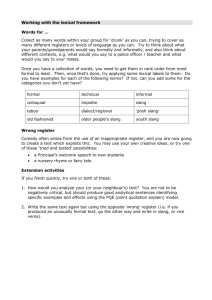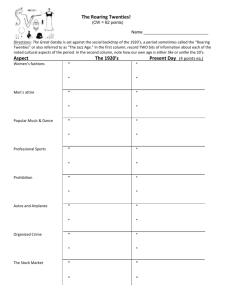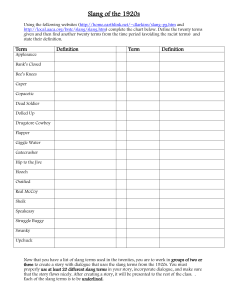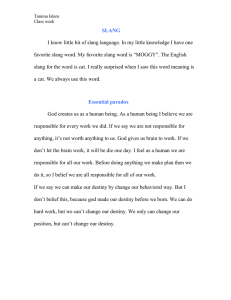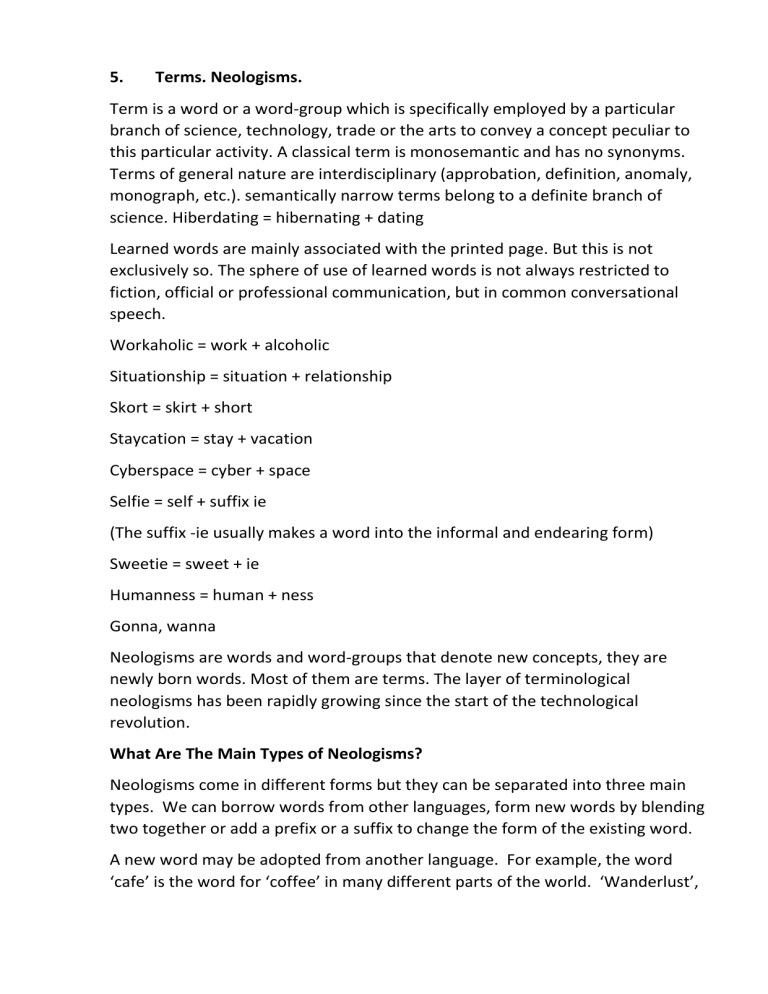
5. Terms. Neologisms. Term is a word or a word-group which is specifically employed by a particular branch of science, technology, trade or the arts to convey a concept peculiar to this particular activity. A classical term is monosemantic and has no synonyms. Terms of general nature are interdisciplinary (approbation, definition, anomaly, monograph, etc.). semantically narrow terms belong to a definite branch of science. Hiberdating = hibernating + dating Learned words are mainly associated with the printed page. But this is not exclusively so. The sphere of use of learned words is not always restricted to fiction, official or professional communication, but in common conversational speech. Workaholic = work + alcoholic Situationship = situation + relationship Skort = skirt + short Staycation = stay + vacation Cyberspace = cyber + space Selfie = self + suffix ie (The suffix -ie usually makes a word into the informal and endearing form) Sweetie = sweet + ie Humanness = human + ness Gonna, wanna Neologisms are words and word-groups that denote new concepts, they are newly born words. Most of them are terms. The layer of terminological neologisms has been rapidly growing since the start of the technological revolution. What Are The Main Types of Neologisms? Neologisms come in different forms but they can be separated into three main types. We can borrow words from other languages, form new words by blending two together or add a prefix or a suffix to change the form of the existing word. A new word may be adopted from another language. For example, the word ‘cafe’ is the word for ‘coffee’ in many different parts of the world. ‘Wanderlust’, ‘cartoon’, and ‘loot’ are other words that have been taken from other languages and are commonly used in English. Common blended words to form new words include: Breakfast + lunch = brunch Hungry + angry = hangry Chill + relax = chillax Confused + puzzled = confuzzled Smoke + fog = smog And it’s common to add the suffix -er to a verb or a noun to describe a person in that area or profession. For example: Instagram = Instagrammar Blog = Blogger Influence = Influencer Facebook = Facebooker Lexical Neologisms Two common elements used to produce new words related to the Internet are cyber- and e-: cybercafé, n. ‘a cafe that offers its customers computers with Internet access’; cyberterrorist, n. ‘a criminal who uses the Internet to do damage to computer systems’; Semantic neologisms – new meanings of already existing words – result from semantic derivation due to the functional mobility of the vocabulary: virus, n. ‘a piece of code which is capable of copying itself and typically has a detrimental effect, such as corrupting the system or destroying data’; 6. 6. Informal layer of the vocabulary. Colloquialisms. Informal words and word-groups are traditionally divided into 3 types: colloquial, slang and dialect words and word-groups. Colloquial words are characteristic of the informal style of spoken English. One should distinguish between literary (standard) colloquial words as units of Standard English and non-literary colloquialisms that belong to sub-standard English vocabulary. Literary colloquial words are used in everyday conversations both by cultivated and uneducated people and are also met in written literary texts. They are closer to neutral words than to literary-bookish units, but, as a rule, have stronger emotional colouring. Non-literary (sub-standard) colloquial words include slang, jargonisms, professionalisms and vulgarisms, dialect words and word-groups. Informal words peculiar for a certain social or professional group should be considered as jargonisms. Jargonisms stand close to slang, also being substandard, expressive and emotive, but unlike slang they are used by limited groups of people, united either professionally or socially. The aim of jargon is to preserve secrecy within one or another social or professional group. Jargonisms are generally neutral words with entirely new meanings imposed on them. 7. 7. Slang. Vulgarisms. The term “slang” originated in the USA at the beginning of the 20th century and then penetrated to the other countries. Slang comprises highly informal words not accepted for dignified use. Slang is represented both as special vocabulary and as a special language. Slang is much rather a spoken than a literary language. Slang words, used by most speakers in very informal communication, are highly emotive and expressive. Such words are expressive sub-standard substitutes for current words of standard vocabulary. As a rule, their meanings are based on metaphor and have a jocular or ironic colouring. But yet all their meanings are based on metaphor, they strike us as singularly unpoetical. Example: spill the tea, salt to (angry), get upset (they are angry or get upset), mood (relatable), to ghost someone (cut off communication with someone). Vulgarisms are coarse words with a strong emotive meaning; words denoting the notions which are taboo in a given speech community, normally avoided in polite conversation. Vulgarisms include: a) expletives and swear words of abusive character; b) obscene (or taboo, four-letter) words which are highly indecent. We should differentiate between 1) those which have lost their shocking power and are not meant to abuse anybody; they serve as mere signals of strong emotions and 2) those which are meant to offend, insult or abuse. Example :
